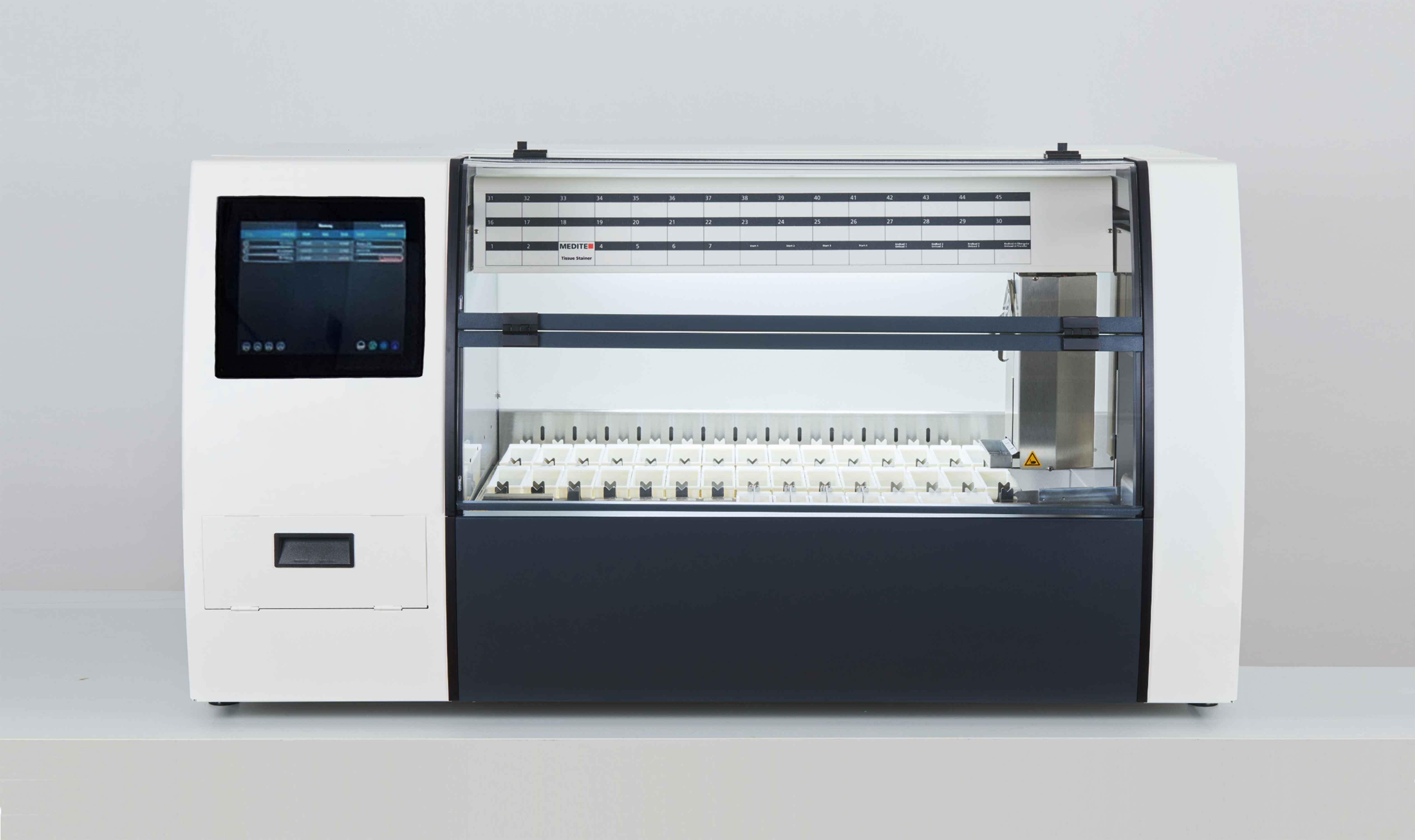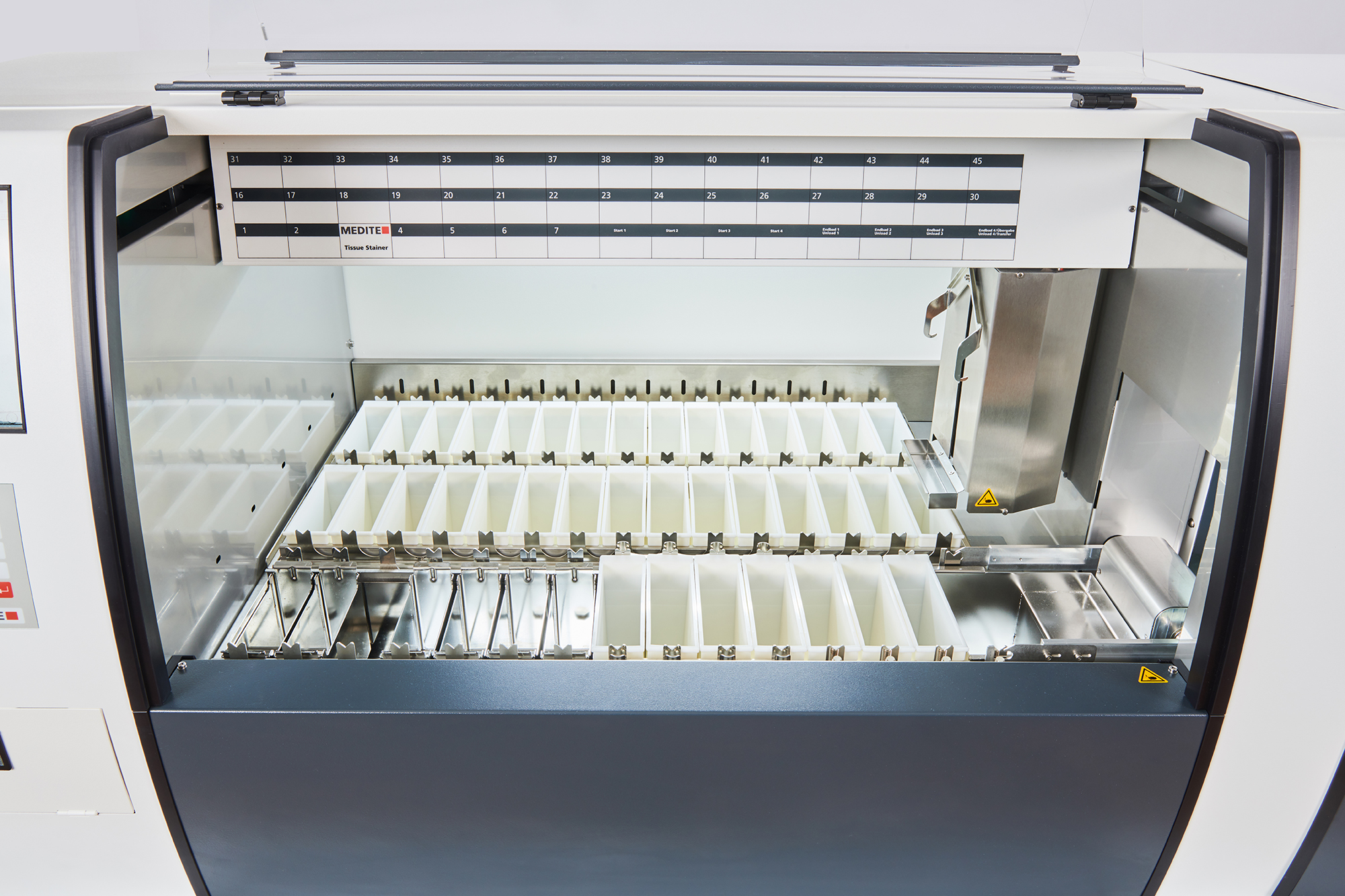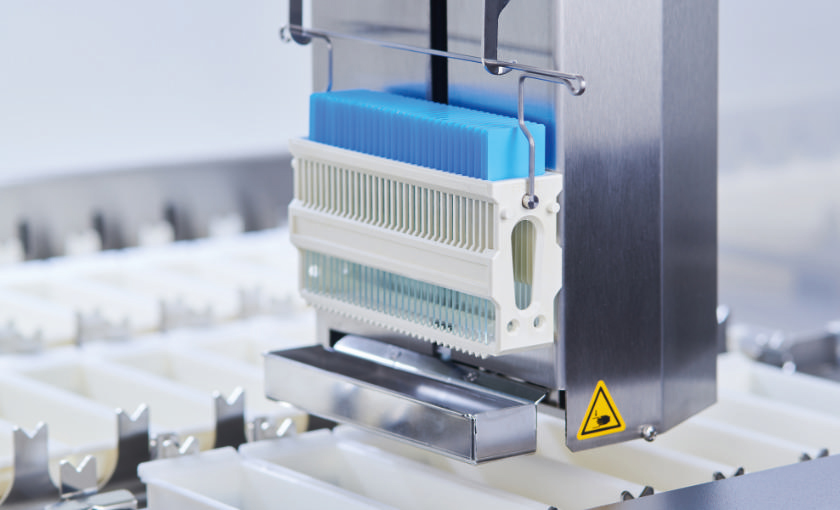Multi-Stainer TST 44+
Easy parallel processing of staining protocols
The programmable Multi-Stainer TST 44+ combines flexibility with speed. Up to 12 protocols for routine and special staining can be processed at the same time. The TST 44+ has a total of 44 stations, including loading and unloading stations, water baths and 30 staining stations. Alternative models with an integrated drying station are also available.
Thanks to the large number of available workstations, different staining protocols can be processed in parallel. Neither the reagent change nor individual steps such as deparaffining need to be done externally. The staining stations work with the agitation technique that ensures gentle treatment of the fluids.
Up to twelve baskets with 30 slides each can be processed at the same time. There are four stations each for loading and unloading. In this way, large quantities of slides can be processed continuously and the laboratory routine becomes more efficient. The TST 44+ also has a backup power feature to prevent interruption and reset of the ongoing process, protecting the sample material from damage.
The fully automatic sequence of the staining protocols is another important factor in efficient work organisation. Up to 50 staining protocols can be saved.
Clever details
The transport head moves in the X, Y and Z directions. It includes a drip tray that reliably prevents liquids that are still sticking to slides or baskets from being carried over. The drip tray automatically slides under the slide basket when it is transported to the next station. Cellulose paper in the tray absorbs the liquids.
The TST 44+ can be used with an activated carbon filter or connected to an external ventilation system. The device supports resource-saving work with the integrated water-saving function. In addition, the current reagent status can be displayed in the menu, enabling an efficient reagent management.
The TST 44+ is operated via a touch display at a comfortable viewing height. The user interface is designed to be simple and enables the protocols to be created easily and quickly called up. The protocol status is shown on the display during operation and can be viewed at any time.
-
- Max. Number Staining Protocols: 50, of which up to 12 protocols can be running simultaneously
- Program Steps: not limited
- Options per Step: bath, time (1 sec. ‒ 59 min.)
- Stations in the Unit: 44 stations, of which: 4 loading and 4 unloading stations, 6 water baths, 30 staining stations with agitation
- Bath Volume: 360 ml, with the option to reduce the volume to 260 ml
- Safety: uninterruptable power supply (UPS)
- Dimensions Overall (W/D/H): 1,210 x 670 x 640 mm
- Weight: ca. 118 kg
- Power Supply:
- 230 V / 50 ‒ 60 Hz / 100 VA
- 115 V / 50 ‒ 60 Hz / 100 VA
-
- Max. Number Staining Protocols: 50, of which up to 12 protocols can be running simultaneously
- Program Steps: not limited
- Options per Step: bath, time (1 sec. ‒ 59 min.)
- Stations in the Unit: 44 stations, of which: 4 loading and 4 unloading stations, 4 water baths, 2 drying stations (temperature adjustable from +40 °C to +90 °C), 30 staining stations with agitation
- Bath Volume: 360 ml, with the option to reduce the volume to 260 ml
- Safety: uninterruptable power supply (UPS)
- Dimensions Overall (W/D/H): 1,210 x 670 x 640 mm
- Weight: ca. 118 kg
- Power Supply:
- 230 V / 50 ‒ 60 Hz / 1200 VA
- 115 V / 50 ‒ 60 Hz / 1200 VA
-
- Max. Number Staining Protocols: 50, of which up to 12 protocols can be running simultaneously
- Program Steps: not limited
- Options per Step: bath, time (1 sec. ‒ 59 min.)
- Stations in the Unit: 44 stations, of which: 4 loading and 4 unloading stations, 6 water baths, 30 staining stations with agitation
- Transfer Station: transfer station for the automatic transfer of the slide holder to the ACS 720 Coverslipper
- Bath Volume: 360 ml, with the option to reduce the volume to 260 ml
- Safety: uninterruptable power supply (UPS)
- Dimensions Overall (W/D/H): 1,210 x 670 x 640 mm
- Weight: ca. 118 kg
- Power Supply:
- 230 V / 50 ‒ 60 Hz / 100 VA
- 115 V / 50 ‒ 60 Hz / 100 VA
-
- Max. Number Staining Protocols: 50, of which up to 12 protocols can be running simultaneously
- Program Steps: not limited
- Options per Step: bath, time (1 sec. ‒ 59 min.)
- Stations in the Unit: 44 stations, of which: 4 loading and 4 unloading stations, 4 water baths, 2 drying stations (temperature adjustable from +40 °C to +90 °C), 30 staining stations with agitation
- Transfer Station: transfer station for the automatic transfer of the slide holder to the ACS 720 Coverslipper
- Bath Volume: 360 ml, with the option to reduce the volume to 260 ml
- Safety: uninterruptable power supply (UPS)
- Dimensions Overall (W/D/H): 1,210 x 670 x 640 mm
- Weight: ca. 118 kg
- Power Supply:
- 230 V / 50 ‒ 60 Hz / 1200 VA
- 115 V / 50 ‒ 60 Hz / 1200 VA


